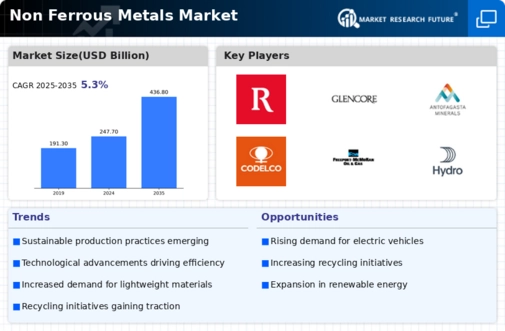Non Ferrous Metals Market Summary
The Global Non Ferrous Metals Market is projected to grow from 247.7 USD Billion in 2024 to 436.8 USD Billion by 2035.
Key Market Trends & Highlights
Non Ferrous Metals Key Trends and Highlights
- The market is expected to experience a compound annual growth rate (CAGR) of 5.29 percent from 2025 to 2035.
- By 2035, the market valuation is anticipated to reach 436.8 USD Billion, indicating robust growth potential.
- In 2024, the market is valued at 247.7 USD Billion, reflecting a strong foundation for future expansion.
- Growing adoption of sustainable technologies due to increasing environmental regulations is a major market driver.
Market Size & Forecast
| 2024 Market Size | 247.7 (USD Billion) |
| 2035 Market Size | 436.8 (USD Billion) |
| CAGR (2025-2035) | 5.29% |
Major Players
Rio Tinto, Glencore, Alcoa Corporation, First Quantum Minerals Ltd, Aluminum Corporation of China Ltd, MMG Ltd, Anglo American plc, Antofagasta plc, Codelco, Vedanta Resources Ltd, South32 Ltd, BHP Group Ltd, FreeportMcMoRan Inc, Glencore International plc, Norsk Hydro AS








